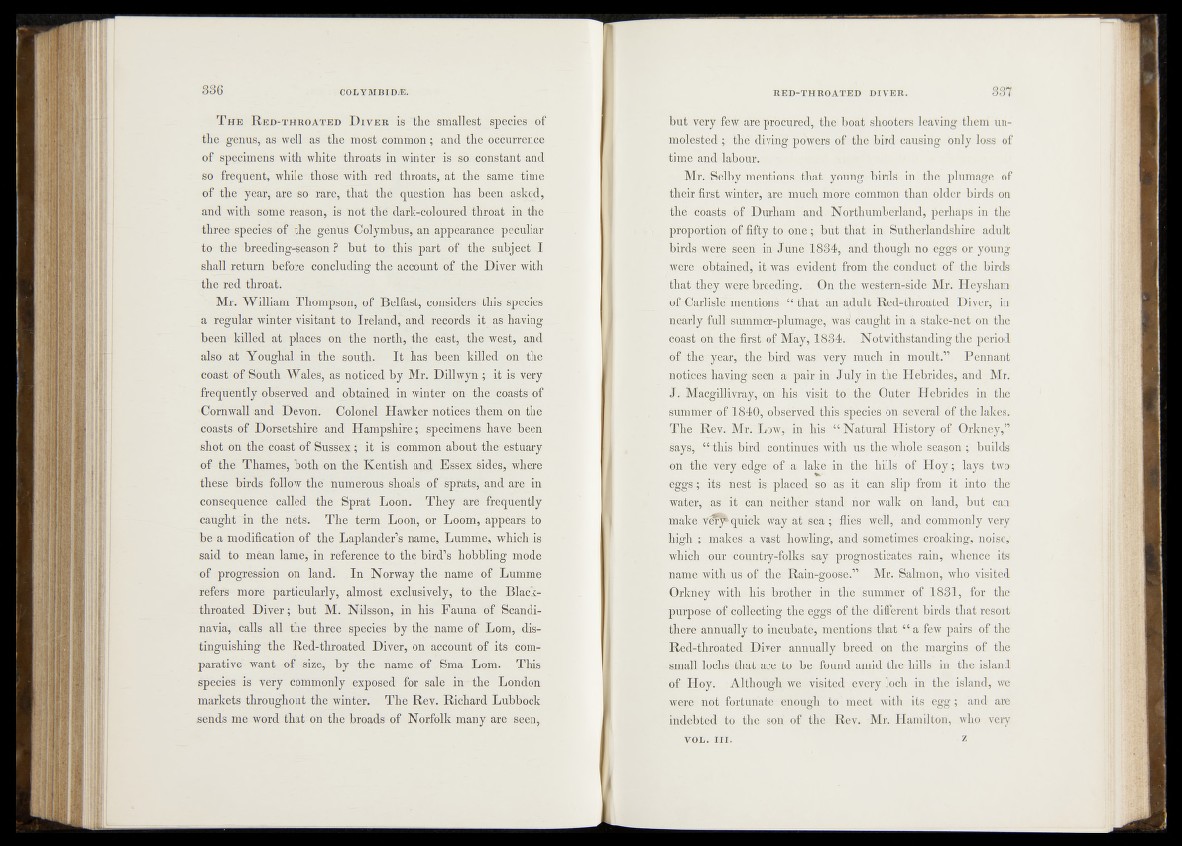
T he R ed-throated D iver is the smallest species of
the genus, as well as the most common; and the Occurrence
of specimens with white throats in winter is so-constant and
so frequent, while those with red throats, at the same time
of the year, are so rare, that thé question has been asked,
and with- some reason, is not the dark-coloured throat in the
three-species of the genus Colymbus, an appearance -peculiar
to the breeding-season ? but to this part of the subject I
shall return before concluding the account of the Diver wip:
the red throat.
Mr. William Thompson, of Belfast, considers this species
a regular winter visitant -to’- Ireland, and’- reeordsrit, as having-
been-hilled at places on the - north, the easty -tho-we&t,4im-d
also at Yoüghal in the south. I t has been-killed on ti|e’
coast of South-Wales, as .noticed by Mr. Dillwyn ^ift is very
frequently observed and obtained in-winter on the^coasts,'©f
*CorhwalI and Devon. & Tj^Monel Hawker motibes^fienr1 on the
coasts of Dorsetshire and Hampshire.* specimens have been
shot on the coast of Sussex; it is corómon about thei.estuary
of the Thames, both on the Kentish apd^Ëssex^sides,
these birds follow the numerous shoals^of sph6fes,-andare in
consequence called the Sprat Loon, They are"fréiqüé®tly
caught in the nets* The term Loon, or Loom, appears db
be a modification of the Laplanders name, Lumme, whkhiris*
said to mèan lame; in reference to the bird’s hobbling mode
of progression on land. In Norway the name of Lumme
refers more particularly, almost exclusively* to the Black-
throated Diver; but M. Nilsson, in nis Fauna of Scandinavia,
Calls all the three species by the'name of Lorn, -distinguishing
the Red-throated Diver, on appuiit of its comparative'
want of size, by the name o f. Sma Lorn. This
species is very commonly exposed for sale in—the London
markets throughout the winter. The Rev. Richard Lubbock
sends me word that on the broads of Norfolk many are seen.
but very few are procured, the boat shooters leaving them unmolested
; the diving potvers of the bird causing only loss of
time and labour.
Mr. Selby mentions that yoiing birds in the plumage of
their first winter, are much more common than older birds on
the coastssr of Durham and. Northumberland, perhaps in the
proportion.of-fiftyuto one; but that in Sutherlandshire adult
Mrds^feetfe seed in June'183.4, and though no eggs or. young
|were ^obtained, it was evident from thé conduct of the birds
that they; were breeding. On the western-side Mr. Heysham
of Carlisle. men-tions^'^ that an adult Red'-throated Divert in
nearly, full summer-plumage, was-caught in k, stake-net on the
coast on-the first'of May, 1834. - Notwithstanding the period
óf thê~year,..thejfbir% was very much-in moult.1'’ Pennant
a pair in Ju ly in the Hebrides; and Mr.
J. Macgillivrayy oh- his visitefco, the’ Outer Hebrides in the
summemof s 18é%5observed|ithfe4species On several of the lakes.
jp|o%:Rev. MrtlLow, in his '“ Natural History of Orkney,”
says,, »JMhis .bird ^continues. with us the whole season ; builds
On the..véry,edge* of aïlake im.tihiej hills of Hoy ; lays two
eggs; its >-4est^fe#placed so as it can slip from it into the
water, as it can' neither^stahd non walk on land, but can
make vdry quick;,way a t sea ;■ flies- well, and commonly very
high;; makesi, a vast howling, and .sometimes., croaking; noise,*
which our country-folks ’say .prognosticates rain, whence its
nam'e^itl'-aas'j®'^bthe Raim-gooSe.” Mr. Salmou, who vkitèd
Orkney, withg^his brother in the summer of 1831, for the
purpose ^collecting the eggs. Of the different birds that resort
there annually to incubate, mentions that “ a few pairs of the
Red-throated Diver annually breed on the margins of the
-Small lochs; that' are to be found amid the: hills in the island
of Hoy. Although- we visited every, loch in the island, we
were not fortunate:: enough to' meet with its egg; and are
indebted to the son of the Rev. Mr. Hamilton, who very